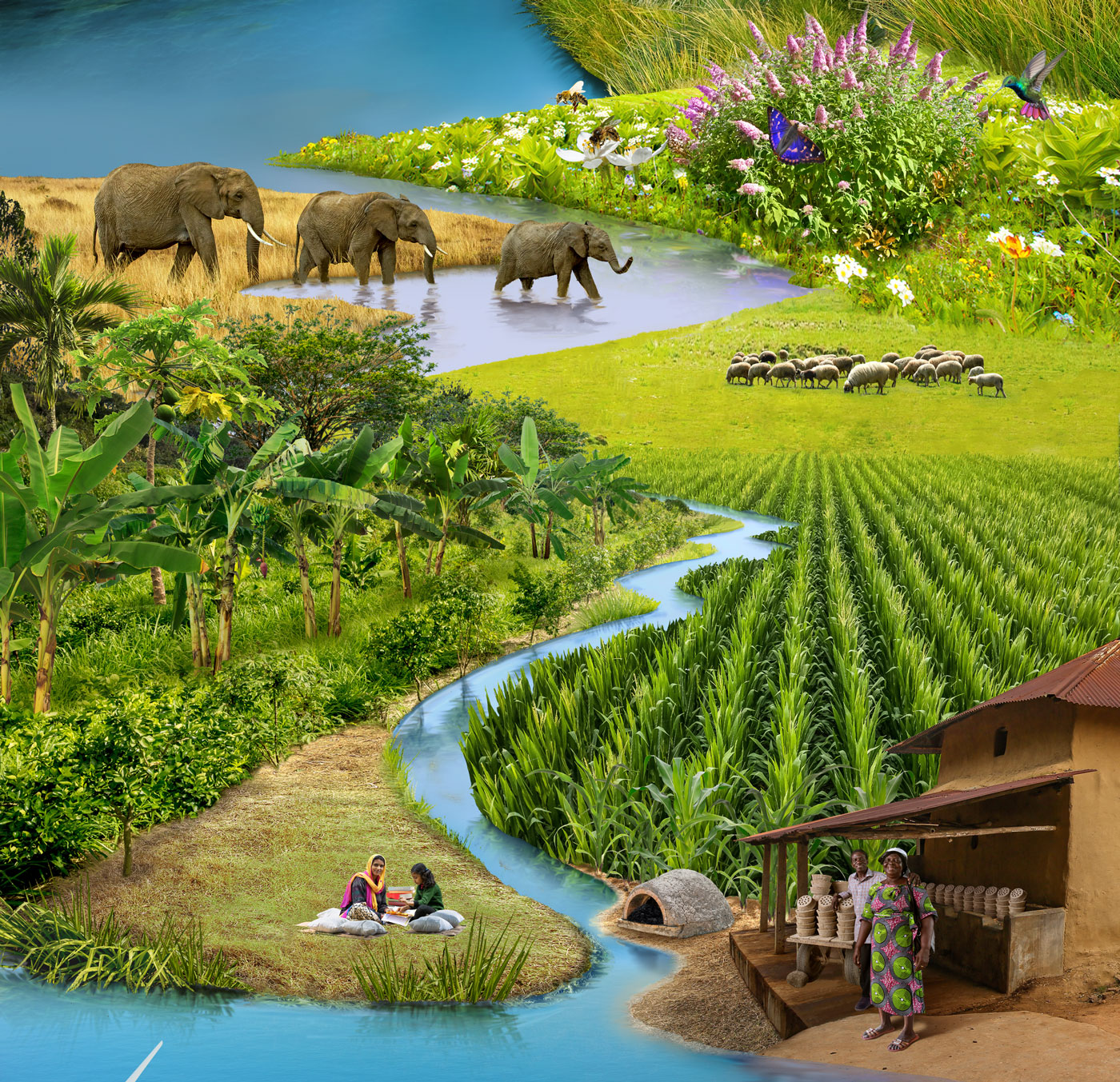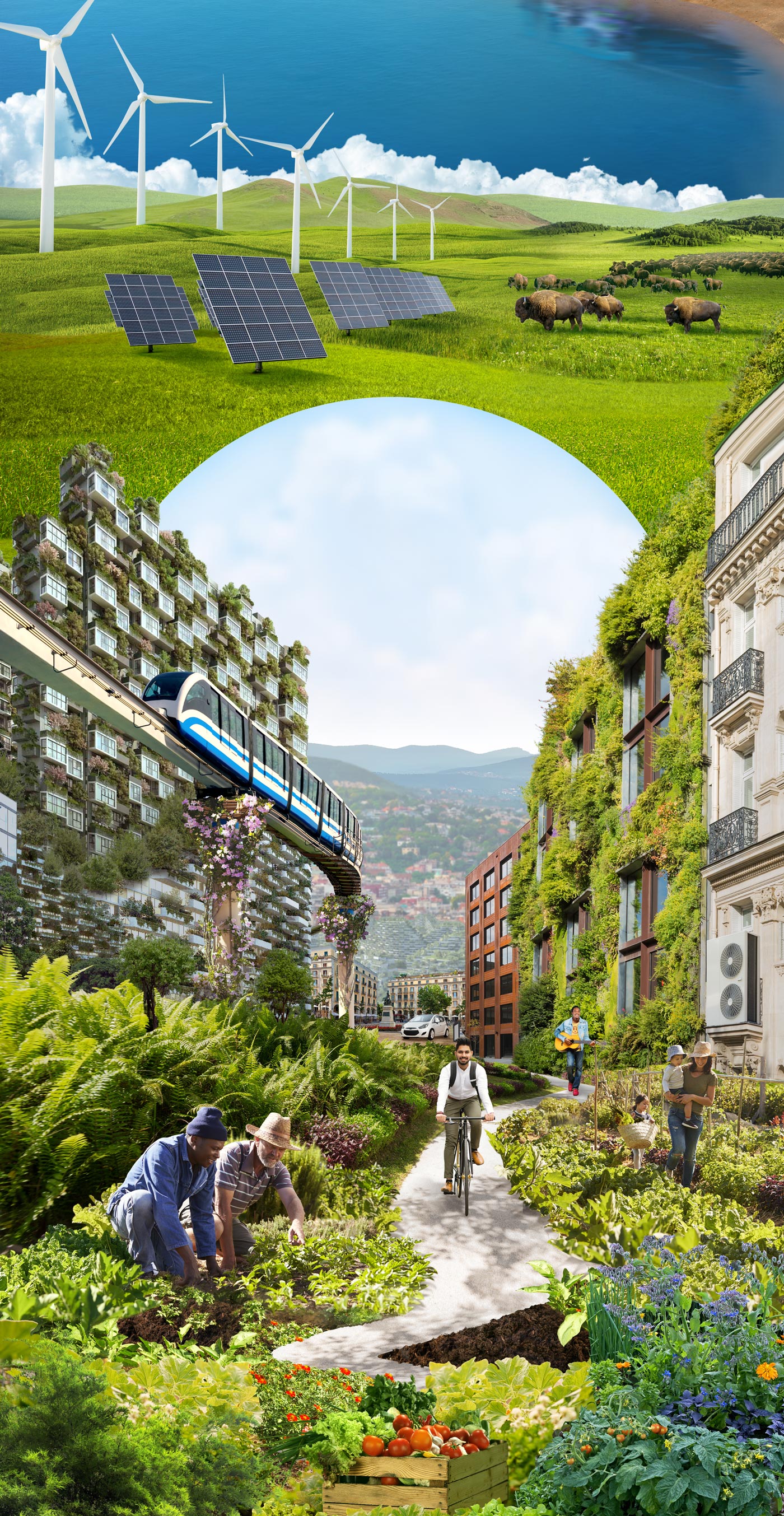Cascade of Solutions
Regeneration puts life at the center of every action and decision. It applies to all of life—grasslands, farms, insects, forests, fish, wetlands, coastlands, and oceans—and it applies equally to family, communities, cities, schools, religion, commerce, and governments. And most spectacularly to climate.
Regeneration is a response to the urgency of the climate crisis, a determined what-to-do manual for all levels of society, from individuals to national governments and everything and everyone in between. It describes a system of interlocking initiatives that can stem the climate crisis in one generation.
If we want to get the attention of humanity, humanity needs to feel it is getting attention. Regeneration creates livelihoods that bring life to people and people to life. It is work that links us to each other’s wellbeing, that provides those in poverty with purpose and a future of dignity and respect.
The heating planet is our commons. It holds us all. To address and reverse warming requires connection and reciprocity. It calls for moving out of our comfort zones to find a depth of courage we may have never known. It calls for action that is bold and fearless.

Bioregions are defined by their unique landscapes and ecosystems, as opposed to political boundaries. There are 185 distinct named bioregions, according to researchers at One Earth. Understanding of bioregions, including watersheds, foodsheds, and habitats, creates political and cultural systems that are in accord with ecological stewardship.

The Boreal wraps around seven countries and comprises 4.2 billion acres, with the highest carbon density of any region on earth. However, Boreal ecosystems are being eaten away and torn apart by mining, oil extraction, and logging. Urgently protecting 30 to 50 percent of intact forest is critical for climate.
See Nexus : Boreal Forests
For decades, beavers had been considered a destructive, tree-killing nuisance that required eradication. Ecologists and scientists have come to the opposite conclusion: that beavers are a keystone species, restorers of habitat for fish, turtles, frogs, and birds. Their activity increases vegetation and groundwater levels, while decreasing stormwater runoff and erosion.
See Nexus : Beavers
Afforestation is the deliberate introduction of trees to land not previously forested. As trees grow, the quantity of carbon stored in their leaves, branches, trunk, bark, and roots can be significant. When careful site and species selection is considered, afforestation is an effective strategy for maximizing carbon sequestration.
See Nexus : Afforestation
Every ecosystem forms a cascade of life; trophic describes the act of feeding, of obtaining nutrition. How an ecosystem is assembled differs with place, with certain keystone species—whether predators, ecosystem engineers, or mutualists—gluing the entire system together. Protecting this natural balance lies at the heart of the regeneration.
Indigenous people have actively used fire for thousands of years to cultivate abundant, productive forests and grasslands. Fire ecology employs carefully timed, low-intensity fires to remove underbrush and regenerate important grasses and perennials. Today, as Indigenous wisdom is being recognized by state and federal authorities, tribes are bringing good fire back.
See Nexus : Fire Ecology
One of the simplest climate solutions is to let tropical forests grow. Deforestation in the tropics is largely driven by the production of four commodities—cattle, soy, palm oil, and wood. Reducing industrial demand for these products, while ensuring Indigenous rights to their land, will protect these irreplaceable webs of life.
See Nexus : Tropical Forests
Known as swamp forests, fens, heaths, bogs, or mires, peatlands are wetland ecosystems where organic matter decomposes slowly and builds up large stores of thick, black carbon. Slash-and-burn deforestation and conversion of peatlands for palm oil plantations releases carbon from these spongy sinks, threatening communities, species, and global climate.
See Nexus : Peatlands
Wetland variations are endless: seasonal or permanent, freshwater or saline. Repositories of carbon, diversity, and life, they help prevent flooding and erosion, and store water in times of drought. Drained for land and fuel, wetlands are under threat the world over, with more than 65 percent lost in the past century.
See Nexus : Wetlands
Forests are the greatest remover of carbon dioxide on the planet, and primary, mature forests are responsible for the majority of that sequestration. Proforestation—protecting intact forests as well as letting degraded forests recover and mature—can have a greater impact on global emissions than any other land-based solution.
See Nexus : Proforestation

One out of every three bites of food we take comes from pollinated plants. Pollinators everywhere are struggling under the rapidly expanding threats of habitat destruction, agricultural pesticides, invasive species, and climate change. From mini-gardens to wetland protection, many options exist for restoring and protecting pollinator pathways.
See Nexus : Pollinators
Wildlife corridors are pathways in water, land, and air in which birds, mammals, invertebrates, reptiles, and insects migrate, feed, drink, and move to and from connected habits to complete their cycle of life. Land conversion, human population growth, physical barriers, and agriculture have strained habitats. When species disappear, ecosystems deteriorate.
See Nexus : Wildlife Corridors
Chickens pecking in crop fields, cattle grazing in orchards, or sheep in vineyards: these examples of animal integration are critical to regeneration. Integrating crops and livestock has multiple benefits including increased balance of nutrients in soil, improved productivity, and reduced risks associated with climate change and market fluctuations.
See Nexus : Animal Integration
Over the past century, trees were removed from agricultural fields as mechanized fence-to-fence production took hold. Today, agroforestry is making a comeback, combining trees, woody perennials, annuals, and livestock. Agroforestry systems include alley cropping, silvopasture, and forest farming—practices which enhance carbon sequestration, while sustainably producing food, fiber, and forage.
See Nexus : Agroforestry
A teaspoon of healthy soil contains one of the most complex living systems on earth. While industrial agriculture fights nature, regenerative agriculture uses farming methods that promote life, biological diversity, human and animal health, plant vigor, and pollinator viability. As an added benefit, healthy soil naturally sequesters atmospheric carbon dioxide.
See Nexus : Regenerative Agriculture
There is overwhelming evidence that an educated populace of women radically reduces infant mortality, child marriage, family size, malaria, and HIV/AIDS. Conversely, it increases health, economic well-being, agricultural yields, and social stability. Realizing the potential of women is the single most important pathway to planetary regeneration.
See Nexus : Girls Education
Biochar is created when organic material is roasted slowly at temperatures above 930 degrees Fahrenheit. The process results in a light, stable substance rich in carbon and highly resistant to decomposition. When added to soils, its crystalline structure houses essential players in regeneration, including microbes, minerals, and water molecules.
See Nexus : Biochar
Clean cookstoves aim to reduce harmful particulate emissions and increase fuel efficiency. Shorter cooking times affords women and girls time to pursue other activities, such as education. Replacing wood with low-emissions fuel sources has the potential to remove approximately 0.4 gigatons of carbon-dioxide-equivalent emissions per year.
See Nexus : Clean Cookstoves

Atmospheric scientist Ken Caldeira points out that 2 percent of the planet’s wind would power all of civilization. In 2019, wind provided 7 percent of U.S. electricity and 5 percent of worldwide electricity. Coupled with solar energy generation, storage, and transmission, wind power can completely replace fossil fuels before 2050.
See Nexus : Wind
Grasslands are among the most endangered ecosystems on the planet. Home to bison, zebra, wildebeest, antelopes, rhino, and livestock, grasslands and savannahs account for 15 percent of global terrestrial carbon storage, 90 percent of which takes place below ground, making it more secure than forests.
See Nexus : Grasslands
The growth of solar energy has been consistently underestimated. The manufactured price per watt in 1955 was $1,785; today it is ten cents. Solar-generating capacity in the United States powers one in eleven homes. Renewable energy can and should be 95 to 100 percent of world energy production, ending fossil fuel combustion.
See Nexus : Solar
Grazing provokes grass regrowth by removing old plant tissue, allowing more sunlight to reach the base of the plant. Animal dung and urine supply natural fertilizers for the plants, including nitrogen. When grazers are displaced or removed from grasslands, the ecology of the system is altered significantly and degrades.
Electrifying everything means replacing a fossil-fuel economy with wind, solar, hydro, electric transport, heat pumps, and a masterfully designed electric grid. Twenty million jobs will be created in the first decade of transformation. Costs will come down. Benefits will accrue. Skies will clear. Cities will be quieter. Homes and offices will be smarter. Life will go on.
See Nexus : Electrify Everything
Imagine cities that are more green than grey, where buildings are clad in vines; landscaped terraces and medians are sanctuaries for birds and pollinators, paved-over creeks are restored, and many species long absent return to dwell in the parks, brooks, and forests. Urban trees and plants mitigate heat, noise, flooding, pollution, and stress all while sequestering carbon and hosting life.
See Nexus : Nature of Cities
Net Zero Cities operate on 100 percent renewable energy. Accomplishing this includes: shuttering all oil and gas production and plants; setting zero-emission standards for buildings; requiring all equipment and vehicles to be electric; and installing the public infrastructure to support this transition. These changes transform the city, eliminating air pollution, noise, and greenhouse gas emissions.
See Nexus : Net Zero Cities
The cities of today are designed for cars, not people. Affordable and accessible low-carbon public transit reopens the city, replacing lonely commutes with buses, subways, trains, and ferries. Not only is it cheaper, safer, healthier, and more accessible, it reduces city emissions significantly.
See Nexus : Urban Mobility
Carbon Architecture is about building with bio-based materials that sequester carbon like wood, dirt (clay), bamboo, straw, and hemp, engineered to compete with the traditional materials of today in durability, fire resistance, and structural strength. This simple act turns a building from a source of emissions to a sink, shrinking the 12 percent of emissions from embodied carbon.
See Nexus : Carbon Architecture
The Fifteen-Minute City is an invitation to redesign the city and put people at the heart. The goal is to have fresh food, healthcare, schools, offices, shops, parks, gyms, banks, and more accessible within 15 minutes for all city dwellers. The cities pursuing this vision are discovering how healthy, lively, and resilient cities can truly be.
See Nexus : Fifteen-Minute City
The age of the internal combustion engine is over. Electric vehicles are faster, safer, quieter, and cheaper. They don’t poison our air nor emit greenhouse gases. As their performance continues to improve and the web of electric chargers grows, the transition accelerates. Soon, the petroleum powered vehicles that produce 16 percent of greenhouse gas emissions will be a relic of the past.
See Nexus : Electric Vehicles
Bikes, scooters, skateboards, rickshaws—all are perfect for short-distance trips and, in many ways, return to the original idea of a city. Replacing cars with micromobility strategies creates an integrated transportation system, leading to new shared spaces that are vibrant places to live, work, play and move.
See Nexus : Micromobility
Heat pumps are like air conditioners that can run backwards and forwards, keeping a stable temperature throughout the year, while being up to 50 percent more efficient. Replacing every gas, electric, or oil burner for heating water or for warmth and cooling will dramatically reduce the 28 percent of emissions associated with operating buildings.
See Nexus : Heat Pumps
AY Young is the creator of The Battery Tour, an ambitious project to inspire action, connection and bring access to energy to countries in need. He has performed over 800 concerts powered exclusively by solar energy across the United States and has sent his innovative solar boxes to 15 developing countries.
AY & Jon Russell have come together to create “We Can Change The World” an anthem for the Regeneration.
The current industrial agricultural food system that produces fast-food, sodas, and inflammatory disease, is responsible for 34 percent of all emissions. Localization is about building regional food systems—purchasing local food from local farmers that is grown in harmony with the environment. It ensures access to healthy, clean food, regenerating people and place.
See Nexus : Localization
Food can be grown anywhere there is light and even in cities. Rooftops, vacant lots, parks, warehouses, medians, and more are being transformed into urban farms, connecting people to fresh food and providing habitats for pollinators. While ultimately unlikely to directly make a large dent in climate change, urban farms reawaken people’s understanding of food and its total impact on human health, happiness, and well-being.
See Nexus : Urban Farming
Composting returns everything created by the land back to whence it came. Decay and decomposition of organic matter into nutrients feeds the soil, accelerating plant growth, improving water-holding capacity, and boosting sequestration. Individual or industrial, active or passive, compost is a climate solution for nearly everyone.
See Nexus : Compost
Rice, wheat, and corn provide 43 percent of the calories we consume or feed to our animals. And yet there are thousands of nutrient-rich edible plants around the world. Diversifying our diet sequesters carbon, protects ecosystems, and heals people. It just requires a little exploration and imagination.
See Nexus : Eating Plants

About 25% of all ice-free land on earth exists in a degraded condition. All land renewal strategies involve rebuilding soil carbon and removing constraints on natural regeneration. Restoring land to health will sequester large amounts of atmospheric carbon in the soil, feed millions of people, improve wildlife habitat, and make water more abundant.
See Nexus : Degraded Land Restoration
Bamboo is the multipurpose climate solution. Growing up to ten feet in a season, it can be eaten, transformed into clothes, turned into biochar, made into toilet paper, used as a construction material, and so much more. When implemented responsibly, bamboo can also restore degraded land, sequester carbon, and provide a steady income.
See Nexus : Bamboo
Tidal salt marshes store more carbon per acre than tropical forests and yet these wetlands are being converted into roads, houses, and agricultural land. Sea level rise also threatens to drown these ecosystems. But tidal salt marshes and their inhabitants are resilient—restoring historical tidal patterns and giving them the space they need will regenerate them.
See Nexus : Tidal Salt Marshes
Mangroves, one of the most carbon-rich ecosystems, are also biodiversity havens and natural disaster buffers. The world has lost nearly 50 percent of them since 1980 to aquaculture projects, illegal logging, and coastal development. Protecting and restoring this “super” ecosystem globally can combat climate change and help millions of people adapt to its impacts.
See Nexus : Mangroves
Marine Protected Areas are one of our best tools to regenerate ocean ecosystems. Yet not all are created equal. The most successful ones are the right size and have enough protections for long enough to ensure that the biodiversity recovers. Roughly 5% of the ocean is protected. The goal is to protect at least 30 percent by 2030.
See Nexus : Marine Protected Areas
Dense underwater grasslands home to some of the world’s largest fisheries, seagrass ecosystems occupy less than 0.1 percent of the ocean and bury around 80 million tons of carbon per year. They are highly endangered—rate of loss has increased to seven percent per year primarily due to pollution and poor water quality. Halting ongoing losses and restoring the remaining seagrasses must be a priority.
See Nexus : Seagrasses
Seaweeds grow fast: kelp can grow up to two feet per day, drawing down more than 2 pounds of carbon in a single square foot annually. Restoring lost kelp forests sequesters carbon and protects fish and coral reefs. At a larger scale, creating artificial kelp forests could draw down gigatons of carbon, locking it away in the deep ocean for thousands of years.
See Nexus : Seaforestation
